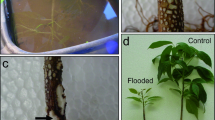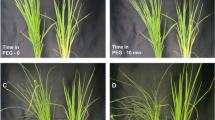Abstract
Inadequate availability of oxygen to theroots is a major growth-limiting factor forplants exposed to waterlogging stress. Spring bread wheat genotypes (Triticumaestivum L.) have been found to differ intheir tolerance to waterlogging. Threespring wheat genotypes tolerant towaterlogging (Ducula, Prl/Sara, andVee/Myna) and two sensitive spring wheatgenotypes (Seri-82, and Kite/Glen) wereevaluated for differences in root anatomyand O2 depletion rates from nutrientsolution in growth chamber experimentsconducted under both aerobic and hypoxicconditions. Plants in the aerobictreatment were grown for four to five weeksunder continuous aerobic conditions. Plantsin the hypoxic treatment were initiallygrown aerobically for two to three weeksfollowed by two to three weeks of hypoxicconditions. The percent root porosityranged from 12 to 20% (v/v) for tolerantgenotypes and from 6 to 8% for sensitivegenotypes grown under hypoxic conditions.Decreasing O2 supply increased therate of O2 uptake in waterloggingtolerant cultivars. Anatomical differencesin root structure between tolerant andsensitive genotypes could not be related toobserved differences in O2 use. Although inconclusive, the results suggestthat in addition to oxygen transport, themovement of photosynthate to the rootsunder waterlogged conditions may also beimportant in conferring tolerance.
Similar content being viewed by others
References
Albrecht, G., S. Krammerer, W. Praznik & E.M. Wiedenroth, 1993. Fructan content of wheat seedlings (Triticum aestivum L.) under hypoxia and following re-aeration. New Phytol 123: 471-476.
Albrecht, G. & E.M. Wiedenroth, 1994. Is long-term hypoxia met by the Pasteur effects in roots of wheat seedlings? Proc Royal Soc Edinburgh 1028: pp. 407-412.
Alpi, A. & H. Beevers, 1983. Effects of O2 concentration on rice seedlings. Plant Physiol 71: 30-34.
Armstrong, W., 1979. Aeration in higher plants. Adv Bot Res 7: 225-331.
Armstrong, W. & T. Webb, 1985. A critical oxygen pressure for root extension in rice. J Exp Bot 36: 1573-1582.
Barrett-Lennard, E.G., P.D. Leighton, F. Buwalda, J. Gibbs, W. Armstrong, C.J. Thomson & H. Greenway, 1988. Effects of growing wheat in hypoxic nutrient solutions and of subsequent transfer to aerated solutions. I. Growth and carbohydrate status of shoot and roots. Aust J Plant Physiol 15: 585-598.
Boru, G., M. van Ginkel, W.E. Kronstad & L. Boersma, 2001. Expression and inheritance to waterlogging stress in wheat. Euphytica 117: 91-98.
Boyer, J.S., 1982. Plant productivity and environment. Science 218: 443-448.
Cai, S., 1990. Differential Response to Waterlogging in Wheat Cultivars (Triticum aestivum L.). Thesis, School of Biological Science, University of Birmingham, United Kingdom.
Crawford, R.M.M., 1982. Physiological response to flooding. In: O.L. Lange, P.S. Nobel, C.B. Osmand & H. Ziegler (Eds.), Physiological Plant Ecology II. Encyclopedia of Plant Physiology, Vol. 12B, pp. 453-477. Springer-Verlag, Heidelberg and New York.
Davies, D.D., 1980. Anaerobic metabolism and the production of organic acid. Metabolism and Respiration. In: D.D. Davies (Ed.), The Biochemistry of Plants, Vol. 2, pp. 571-611. Academic Press, New York.
Drew, M.C., 1991. Oxygen deficiency in the root environment and plant mineral nutrition. In: M.B. Jackson et al. (Eds.), Plant Life Under Oxygen Deprivation, pp. 301-316. Academic Publishing, The Hague, Netherlands.
Erdmann, B., P. Hoffmann & E.M. Wiedenroth, 1986. Change in root system of wheat seedlings following root anaerobiosis: I. Anatomy and respiration in Triticum aestivum L. Ann Bot 58: 597-605.
Gardiner, D.T., N.W. Christensen & D.D. Myrold, 1990. A comparison of methods for estimating phosphorus uptake kinetics under steady-state conditions. J Plant Nutr 13: 1079-1093.
Haldemann, C. & R. Brändle, 1983. Avoidance of oxygen deficit stress and release of oxygen by stalked rhizomes of Shoenoplectus lacustris. Physiol Veg 21(1): 109-113.
Huang, B. & J.W. Johnson, 1995. Root respiration and carbohydrate status of two wheat genotypes in response to hypoxia. Ann Bot 75: 427-432.
Huang, B., J.W. Johnson, D.S. NeSmith & D.C. Bridges, 1994a. Growth, physiology, and anatomical response of two wheat genotypes to waterlogging and nutrient supply. J Exp Bot 54: 193-202.
Huang, B., J.W. Johnson, D.S. NeSmith & D.C. Bridges, 1994b. Root and shoot growth of wheat genotypes in response to hypoxia and subsequent resumption of aeration. Crop Sci 34: 1538-1544.
Jensen, C.R., R.J. Luxmoore, S.D. Van Gundy & L.H. Stolzy, 1969. Root air measurements by a pycnometer method. Agron J 61: 474-475.
Justin, S.H.F.W. & W. Armstrong, 1987. The anatomical characteristics of roots and plant response to soils flooding. New Phytol 106: 465-495.
Lann, P., M. Tosserams, C.W.P.M. Blom & B.W. Veen, 1990. Internal oxygen transport in Rumex species and it significance for respiration under hypoxic conditions. Plant Soils 122: 39-46.
McDonald, M.P., N.W. Galwey, P. Ellneskog-Staam & T.D. Colmer, 2001. Evaluation of Lophopyrum eleongatum as a source of genetic diversity to increase the waterlogging tolerance of hexaploid wheat (Triticum aestivum). New Phytol 151: 369-380.
McManmon, M. & R.M.M. Crawford, 1971. A metabolic theory of flooding tolerance: The significance of enzyme distribution and behavior. New Phytol 70: 299-306.
Pfister-Sieber, M. & R. Brändle, 1994. Aspects of plant behavior under anoxia and post anoxia. Proc Royal Soc Edinburgh 102B: 313-324.
Ponnamperuma, F.N., 1972. The chemistry of submerged soils. Adv Agron 24: 29-95.
Prioul, J.L. & C. Guyot, 1985. Role of oxygen transport and nitrate metabolism in the adaptation of wheat plants to root anaerobiosis. Physiol Veg 23(2): 175-185.
Sayre, K.D., M. van Ginkel, S. Rajaram & I. Ortiz-Monasterio, 1994. Tolerance to waterlogging losses in spring bread wheat: effect of time of onset on expression. In: Annual Wheat Newsletter, Vol. 40, pp. 165-171. June 1994. Colorado State University, CO.
Setter, T.L., I. Waters, H. Greenway, B.J. Atwell & T. Kupkanchanakul, 1987. Carbohydrate status of terrestrial plants during flooding. In: R.M.M. Crawford (Ed.), Plant Life in Aquatic and Amphibious Habitats, pp. 411-433, Blackwell, Oxford.
Setter, T. & B. Belford, 1990. Waterlogging: How it reduces plant growth and how plants can overcome its effects. WAJ Agric 31: 51-57.
Thomson, C.J., B.J. Atwell & H. Greenway, 1989. Response of wheat seedlings to low O2 concentrations in nutrient solution. J Exp Bot 70(218): 985-991.
Thomson, C.J., W. Armstrong, I. Watters & H. Greenway, 1990. Aerenchyma formation and associated oxygen movement in seminal and nodal roots of wheat. Plant Cell Envir 13: 395-403.
Thomson, C.J., T.D. Colmer, E.L.J. Watkin & H. Greenway, 1992. Tolerance of wheat (Triticum aestivum cvs Gamenya and Kite), and triticale (Triticosecale cv.Muir) to waterlogging. New Phytol 120: 335-344.
Trought, M.C.T. & M.C. Drew, 1980a. The development of waterlogging damage in wheat seedlings (Triticum aestivum). I. Shoot and root growth in relation to changes in the concentrations of dissolved gases and solutes in the soil solution. Plant Soil 54: 77-94.
Trought, M.C.T. & M.C. Drew, 1980b. The development of waterlogging damage in young wheat plants in anaerobic solution cultures. J Exp Bot 31: 1573-1585.
Ueckert T., T. Hurk, I. Fendrik & E.G. Niemann, 1990. Radial gas diffusion from roots of rice (Oryza sativa L.) and Kallar grass (Leptochloa fusca L. Kunth), and effect of inoculation with Azospirillum brasilense Cd. Plant Soil 122: 59-65.
Van Ginkel, M., S. Rajaram & M. Thijssen, 1991. Waterlogging in wheat: Germplasm evaluation and methodology development. In: D.G. Tanner & W. Mwangi (Eds.), The 7th Regional Wheat Workshop for Eastern, Central, and Southern Africa, pp. 115-124. Najuru, Kenya, Sept. 16-19, 1991.
Veen, B.W., 1977. The uptake of potassium, nitrate, water, and oxygen by maize root system in relation to its size. J Exp Bot 28: 1389-1398.
Yu, P.T., L.H. Stolzy & J. Letey, 1969. Survival of plants under prolonged flooded conditions. Agron J 61: 844-847.
Author information
Authors and Affiliations
Rights and permissions
About this article
Cite this article
Boru, G., van Ginkel, M., Trethowan, R. et al. Oxygen use from solution by wheat genotypes differing in tolerance to waterlogging. Euphytica 132, 151–158 (2003). https://doi.org/10.1023/A:1024622405505
Issue Date:
DOI: https://doi.org/10.1023/A:1024622405505




